HLSC220 Healthcare Ethics: Patient Violence Ethical Dilemma
VerifiedAdded on 2022/09/08
|8
|2089
|33
Essay
AI Summary
This essay delves into the complex ethical dilemma faced by healthcare professionals when confronted with patient violence. The analysis begins by establishing the importance of ethics in healthcare, emphasizing its role in guiding decisions and fostering positive patient-professional relationships. The core of the essay focuses on the ethical principles that come into play when a healthcare provider experiences violence from a patient, specifically addressing whether the professional is ethically obligated to continue treatment. The discussion explores different ethical theories, including virtue ethics and utilitarianism, to examine the conflicting rights and responsibilities of both the healthcare professional and the patient. The essay references the ethical guidelines provided by Beauchamp & Childress, highlighting the principles of autonomy, beneficence, non-maleficence, and justice. It also considers the impact of workplace violence on service quality and the importance of providing a safe environment for healthcare workers. The conclusion supports the healthcare professional's right to refuse treatment in cases of violence, while acknowledging the complexities of patient care, particularly with mentally ill or impaired patients. The essay underscores the importance of ethical training, effective communication, and organizational policies to address and mitigate violence in healthcare settings.
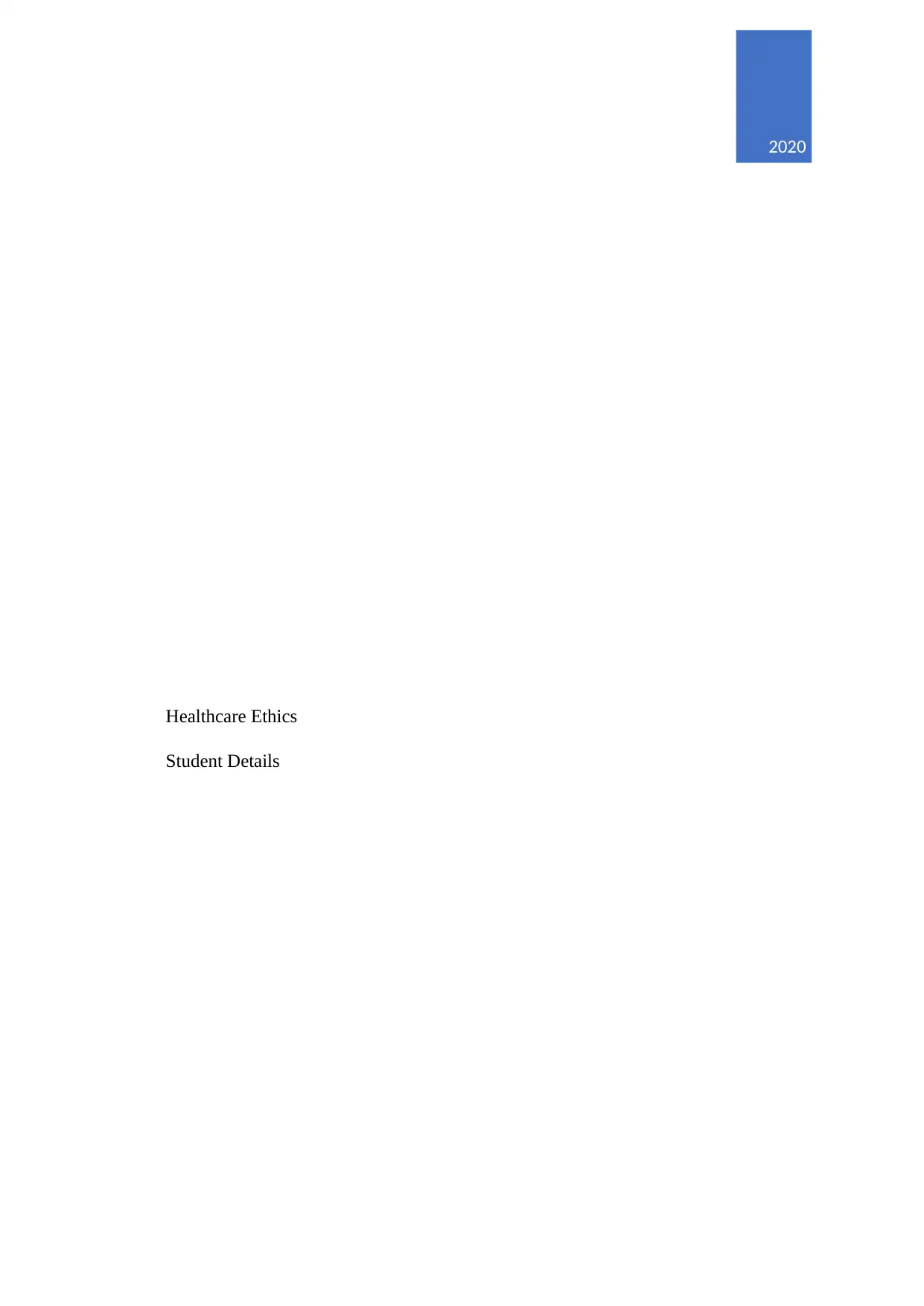
2020
Healthcare Ethics
Student Details
Healthcare Ethics
Student Details
Paraphrase This Document
Need a fresh take? Get an instant paraphrase of this document with our AI Paraphraser
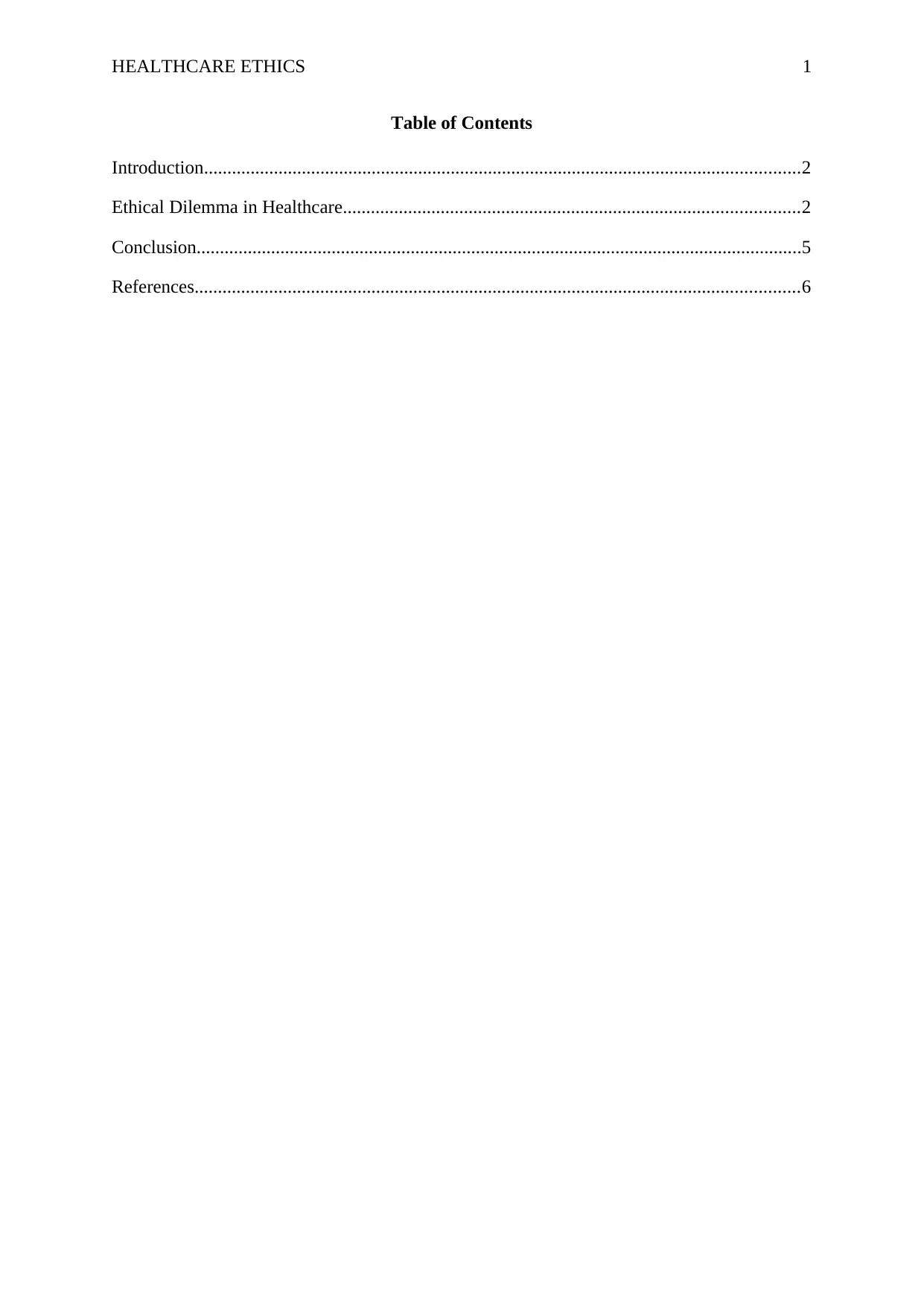
HEALTHCARE ETHICS 1
Table of Contents
Introduction................................................................................................................................2
Ethical Dilemma in Healthcare..................................................................................................2
Conclusion..................................................................................................................................5
References..................................................................................................................................6
Table of Contents
Introduction................................................................................................................................2
Ethical Dilemma in Healthcare..................................................................................................2
Conclusion..................................................................................................................................5
References..................................................................................................................................6
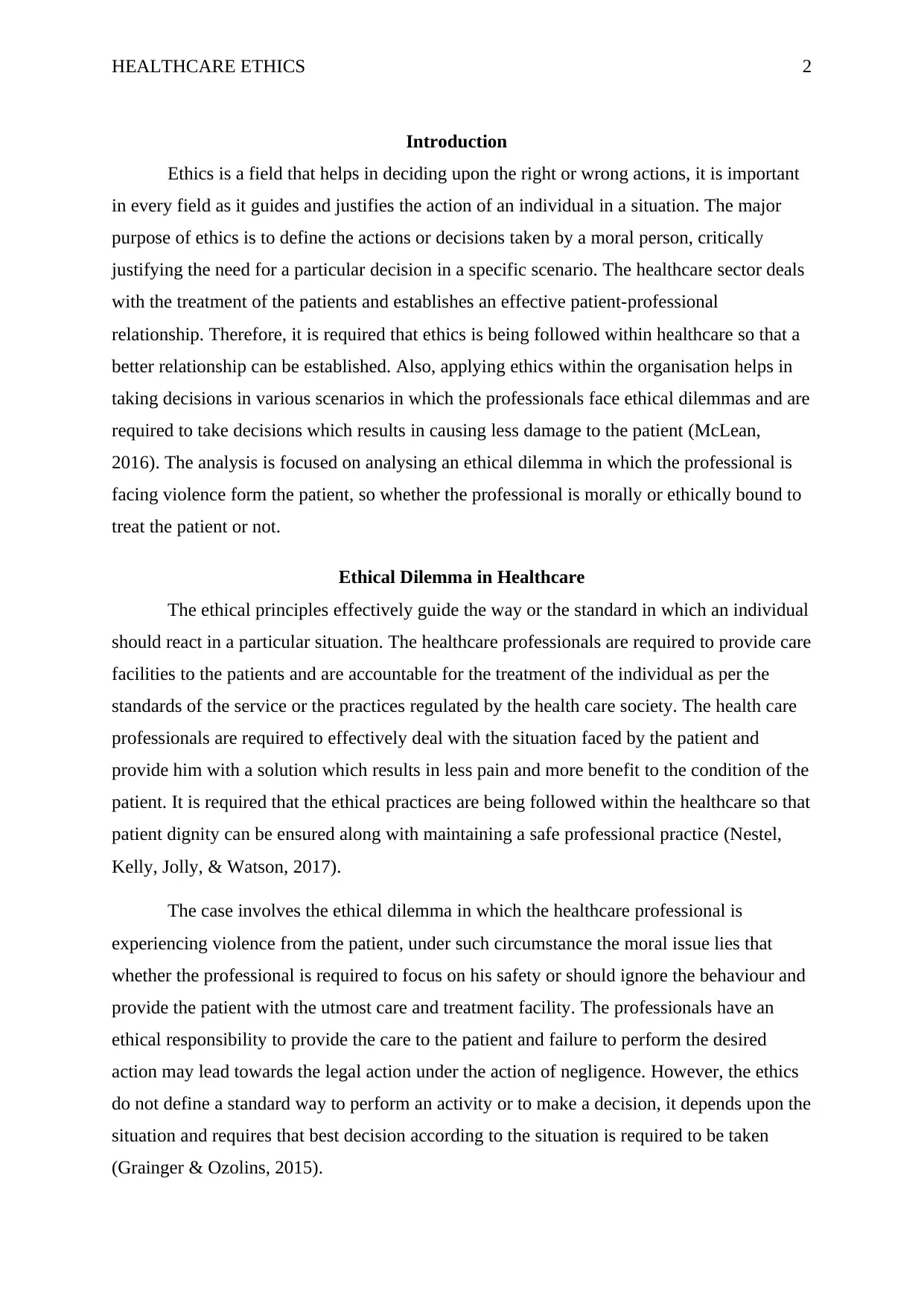
HEALTHCARE ETHICS 2
Introduction
Ethics is a field that helps in deciding upon the right or wrong actions, it is important
in every field as it guides and justifies the action of an individual in a situation. The major
purpose of ethics is to define the actions or decisions taken by a moral person, critically
justifying the need for a particular decision in a specific scenario. The healthcare sector deals
with the treatment of the patients and establishes an effective patient-professional
relationship. Therefore, it is required that ethics is being followed within healthcare so that a
better relationship can be established. Also, applying ethics within the organisation helps in
taking decisions in various scenarios in which the professionals face ethical dilemmas and are
required to take decisions which results in causing less damage to the patient (McLean,
2016). The analysis is focused on analysing an ethical dilemma in which the professional is
facing violence form the patient, so whether the professional is morally or ethically bound to
treat the patient or not.
Ethical Dilemma in Healthcare
The ethical principles effectively guide the way or the standard in which an individual
should react in a particular situation. The healthcare professionals are required to provide care
facilities to the patients and are accountable for the treatment of the individual as per the
standards of the service or the practices regulated by the health care society. The health care
professionals are required to effectively deal with the situation faced by the patient and
provide him with a solution which results in less pain and more benefit to the condition of the
patient. It is required that the ethical practices are being followed within the healthcare so that
patient dignity can be ensured along with maintaining a safe professional practice (Nestel,
Kelly, Jolly, & Watson, 2017).
The case involves the ethical dilemma in which the healthcare professional is
experiencing violence from the patient, under such circumstance the moral issue lies that
whether the professional is required to focus on his safety or should ignore the behaviour and
provide the patient with the utmost care and treatment facility. The professionals have an
ethical responsibility to provide the care to the patient and failure to perform the desired
action may lead towards the legal action under the action of negligence. However, the ethics
do not define a standard way to perform an activity or to make a decision, it depends upon the
situation and requires that best decision according to the situation is required to be taken
(Grainger & Ozolins, 2015).
Introduction
Ethics is a field that helps in deciding upon the right or wrong actions, it is important
in every field as it guides and justifies the action of an individual in a situation. The major
purpose of ethics is to define the actions or decisions taken by a moral person, critically
justifying the need for a particular decision in a specific scenario. The healthcare sector deals
with the treatment of the patients and establishes an effective patient-professional
relationship. Therefore, it is required that ethics is being followed within healthcare so that a
better relationship can be established. Also, applying ethics within the organisation helps in
taking decisions in various scenarios in which the professionals face ethical dilemmas and are
required to take decisions which results in causing less damage to the patient (McLean,
2016). The analysis is focused on analysing an ethical dilemma in which the professional is
facing violence form the patient, so whether the professional is morally or ethically bound to
treat the patient or not.
Ethical Dilemma in Healthcare
The ethical principles effectively guide the way or the standard in which an individual
should react in a particular situation. The healthcare professionals are required to provide care
facilities to the patients and are accountable for the treatment of the individual as per the
standards of the service or the practices regulated by the health care society. The health care
professionals are required to effectively deal with the situation faced by the patient and
provide him with a solution which results in less pain and more benefit to the condition of the
patient. It is required that the ethical practices are being followed within the healthcare so that
patient dignity can be ensured along with maintaining a safe professional practice (Nestel,
Kelly, Jolly, & Watson, 2017).
The case involves the ethical dilemma in which the healthcare professional is
experiencing violence from the patient, under such circumstance the moral issue lies that
whether the professional is required to focus on his safety or should ignore the behaviour and
provide the patient with the utmost care and treatment facility. The professionals have an
ethical responsibility to provide the care to the patient and failure to perform the desired
action may lead towards the legal action under the action of negligence. However, the ethics
do not define a standard way to perform an activity or to make a decision, it depends upon the
situation and requires that best decision according to the situation is required to be taken
(Grainger & Ozolins, 2015).
⊘ This is a preview!⊘
Do you want full access?
Subscribe today to unlock all pages.

Trusted by 1+ million students worldwide
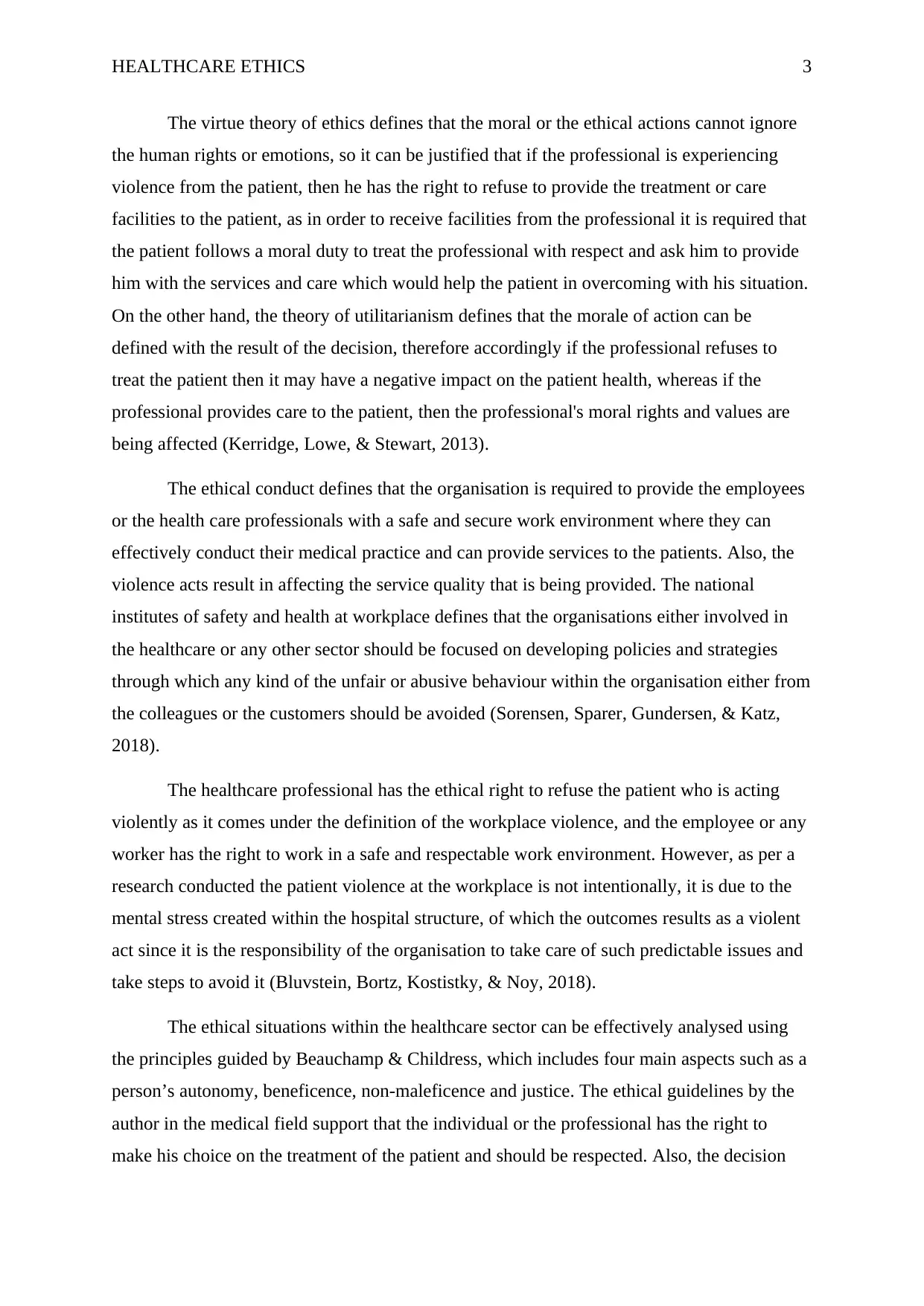
HEALTHCARE ETHICS 3
The virtue theory of ethics defines that the moral or the ethical actions cannot ignore
the human rights or emotions, so it can be justified that if the professional is experiencing
violence from the patient, then he has the right to refuse to provide the treatment or care
facilities to the patient, as in order to receive facilities from the professional it is required that
the patient follows a moral duty to treat the professional with respect and ask him to provide
him with the services and care which would help the patient in overcoming with his situation.
On the other hand, the theory of utilitarianism defines that the morale of action can be
defined with the result of the decision, therefore accordingly if the professional refuses to
treat the patient then it may have a negative impact on the patient health, whereas if the
professional provides care to the patient, then the professional's moral rights and values are
being affected (Kerridge, Lowe, & Stewart, 2013).
The ethical conduct defines that the organisation is required to provide the employees
or the health care professionals with a safe and secure work environment where they can
effectively conduct their medical practice and can provide services to the patients. Also, the
violence acts result in affecting the service quality that is being provided. The national
institutes of safety and health at workplace defines that the organisations either involved in
the healthcare or any other sector should be focused on developing policies and strategies
through which any kind of the unfair or abusive behaviour within the organisation either from
the colleagues or the customers should be avoided (Sorensen, Sparer, Gundersen, & Katz,
2018).
The healthcare professional has the ethical right to refuse the patient who is acting
violently as it comes under the definition of the workplace violence, and the employee or any
worker has the right to work in a safe and respectable work environment. However, as per a
research conducted the patient violence at the workplace is not intentionally, it is due to the
mental stress created within the hospital structure, of which the outcomes results as a violent
act since it is the responsibility of the organisation to take care of such predictable issues and
take steps to avoid it (Bluvstein, Bortz, Kostistky, & Noy, 2018).
The ethical situations within the healthcare sector can be effectively analysed using
the principles guided by Beauchamp & Childress, which includes four main aspects such as a
person’s autonomy, beneficence, non-maleficence and justice. The ethical guidelines by the
author in the medical field support that the individual or the professional has the right to
make his choice on the treatment of the patient and should be respected. Also, the decision
The virtue theory of ethics defines that the moral or the ethical actions cannot ignore
the human rights or emotions, so it can be justified that if the professional is experiencing
violence from the patient, then he has the right to refuse to provide the treatment or care
facilities to the patient, as in order to receive facilities from the professional it is required that
the patient follows a moral duty to treat the professional with respect and ask him to provide
him with the services and care which would help the patient in overcoming with his situation.
On the other hand, the theory of utilitarianism defines that the morale of action can be
defined with the result of the decision, therefore accordingly if the professional refuses to
treat the patient then it may have a negative impact on the patient health, whereas if the
professional provides care to the patient, then the professional's moral rights and values are
being affected (Kerridge, Lowe, & Stewart, 2013).
The ethical conduct defines that the organisation is required to provide the employees
or the health care professionals with a safe and secure work environment where they can
effectively conduct their medical practice and can provide services to the patients. Also, the
violence acts result in affecting the service quality that is being provided. The national
institutes of safety and health at workplace defines that the organisations either involved in
the healthcare or any other sector should be focused on developing policies and strategies
through which any kind of the unfair or abusive behaviour within the organisation either from
the colleagues or the customers should be avoided (Sorensen, Sparer, Gundersen, & Katz,
2018).
The healthcare professional has the ethical right to refuse the patient who is acting
violently as it comes under the definition of the workplace violence, and the employee or any
worker has the right to work in a safe and respectable work environment. However, as per a
research conducted the patient violence at the workplace is not intentionally, it is due to the
mental stress created within the hospital structure, of which the outcomes results as a violent
act since it is the responsibility of the organisation to take care of such predictable issues and
take steps to avoid it (Bluvstein, Bortz, Kostistky, & Noy, 2018).
The ethical situations within the healthcare sector can be effectively analysed using
the principles guided by Beauchamp & Childress, which includes four main aspects such as a
person’s autonomy, beneficence, non-maleficence and justice. The ethical guidelines by the
author in the medical field support that the individual or the professional has the right to
make his choice on the treatment of the patient and should be respected. Also, the decision
Paraphrase This Document
Need a fresh take? Get an instant paraphrase of this document with our AI Paraphraser
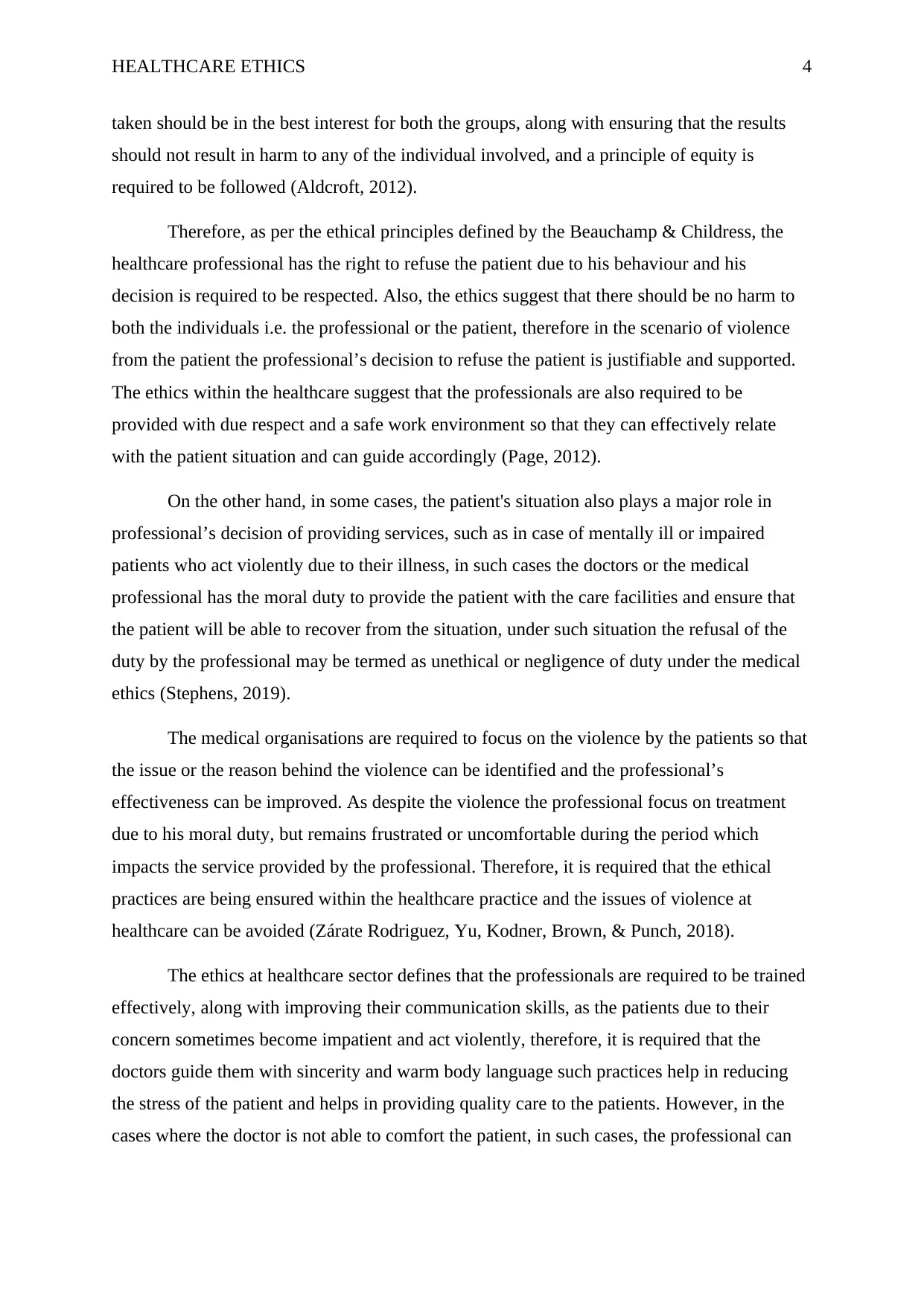
HEALTHCARE ETHICS 4
taken should be in the best interest for both the groups, along with ensuring that the results
should not result in harm to any of the individual involved, and a principle of equity is
required to be followed (Aldcroft, 2012).
Therefore, as per the ethical principles defined by the Beauchamp & Childress, the
healthcare professional has the right to refuse the patient due to his behaviour and his
decision is required to be respected. Also, the ethics suggest that there should be no harm to
both the individuals i.e. the professional or the patient, therefore in the scenario of violence
from the patient the professional’s decision to refuse the patient is justifiable and supported.
The ethics within the healthcare suggest that the professionals are also required to be
provided with due respect and a safe work environment so that they can effectively relate
with the patient situation and can guide accordingly (Page, 2012).
On the other hand, in some cases, the patient's situation also plays a major role in
professional’s decision of providing services, such as in case of mentally ill or impaired
patients who act violently due to their illness, in such cases the doctors or the medical
professional has the moral duty to provide the patient with the care facilities and ensure that
the patient will be able to recover from the situation, under such situation the refusal of the
duty by the professional may be termed as unethical or negligence of duty under the medical
ethics (Stephens, 2019).
The medical organisations are required to focus on the violence by the patients so that
the issue or the reason behind the violence can be identified and the professional’s
effectiveness can be improved. As despite the violence the professional focus on treatment
due to his moral duty, but remains frustrated or uncomfortable during the period which
impacts the service provided by the professional. Therefore, it is required that the ethical
practices are being ensured within the healthcare practice and the issues of violence at
healthcare can be avoided (Zárate Rodriguez, Yu, Kodner, Brown, & Punch, 2018).
The ethics at healthcare sector defines that the professionals are required to be trained
effectively, along with improving their communication skills, as the patients due to their
concern sometimes become impatient and act violently, therefore, it is required that the
doctors guide them with sincerity and warm body language such practices help in reducing
the stress of the patient and helps in providing quality care to the patients. However, in the
cases where the doctor is not able to comfort the patient, in such cases, the professional can
taken should be in the best interest for both the groups, along with ensuring that the results
should not result in harm to any of the individual involved, and a principle of equity is
required to be followed (Aldcroft, 2012).
Therefore, as per the ethical principles defined by the Beauchamp & Childress, the
healthcare professional has the right to refuse the patient due to his behaviour and his
decision is required to be respected. Also, the ethics suggest that there should be no harm to
both the individuals i.e. the professional or the patient, therefore in the scenario of violence
from the patient the professional’s decision to refuse the patient is justifiable and supported.
The ethics within the healthcare suggest that the professionals are also required to be
provided with due respect and a safe work environment so that they can effectively relate
with the patient situation and can guide accordingly (Page, 2012).
On the other hand, in some cases, the patient's situation also plays a major role in
professional’s decision of providing services, such as in case of mentally ill or impaired
patients who act violently due to their illness, in such cases the doctors or the medical
professional has the moral duty to provide the patient with the care facilities and ensure that
the patient will be able to recover from the situation, under such situation the refusal of the
duty by the professional may be termed as unethical or negligence of duty under the medical
ethics (Stephens, 2019).
The medical organisations are required to focus on the violence by the patients so that
the issue or the reason behind the violence can be identified and the professional’s
effectiveness can be improved. As despite the violence the professional focus on treatment
due to his moral duty, but remains frustrated or uncomfortable during the period which
impacts the service provided by the professional. Therefore, it is required that the ethical
practices are being ensured within the healthcare practice and the issues of violence at
healthcare can be avoided (Zárate Rodriguez, Yu, Kodner, Brown, & Punch, 2018).
The ethics at healthcare sector defines that the professionals are required to be trained
effectively, along with improving their communication skills, as the patients due to their
concern sometimes become impatient and act violently, therefore, it is required that the
doctors guide them with sincerity and warm body language such practices help in reducing
the stress of the patient and helps in providing quality care to the patients. However, in the
cases where the doctor is not able to comfort the patient, in such cases, the professional can
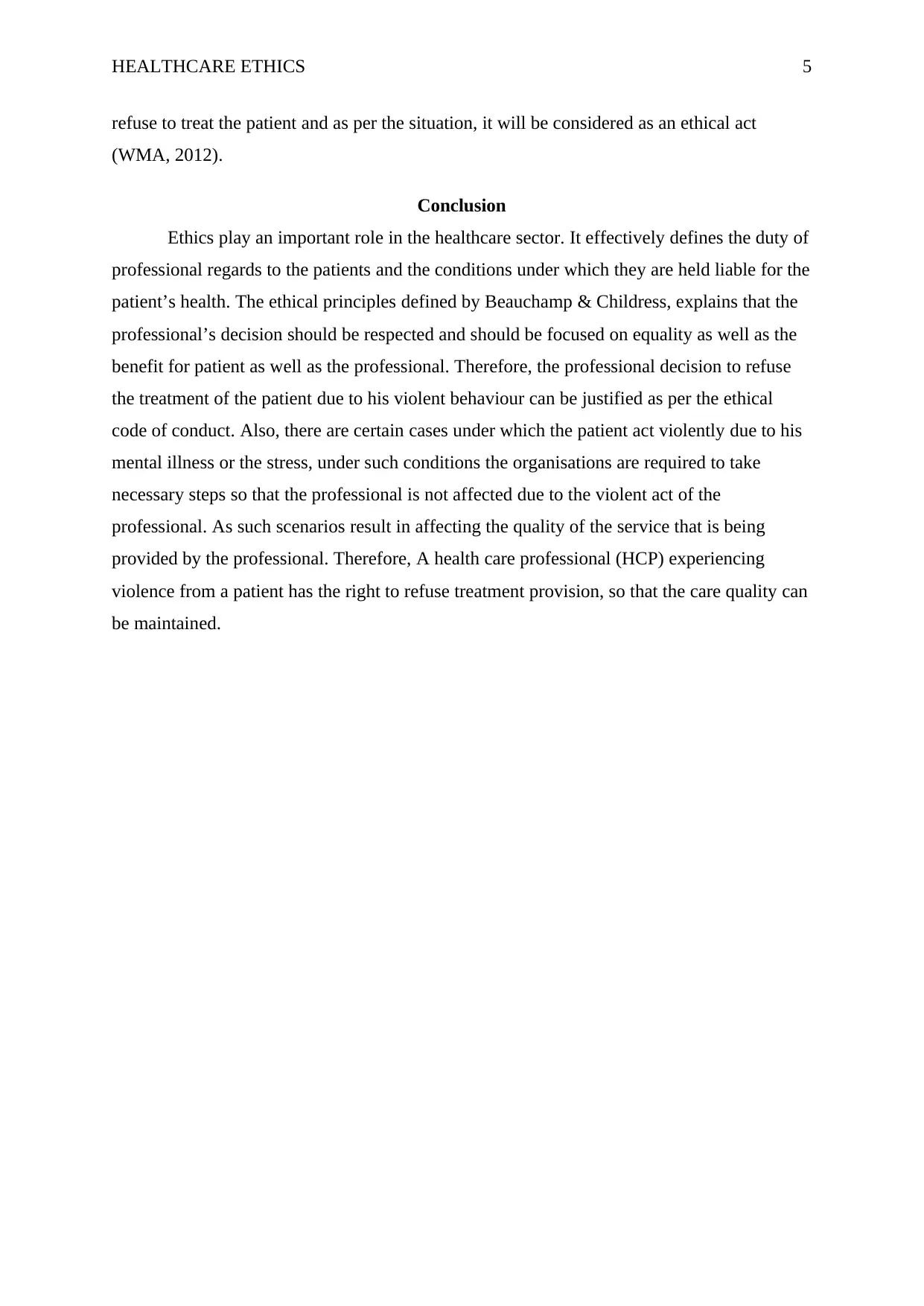
HEALTHCARE ETHICS 5
refuse to treat the patient and as per the situation, it will be considered as an ethical act
(WMA, 2012).
Conclusion
Ethics play an important role in the healthcare sector. It effectively defines the duty of
professional regards to the patients and the conditions under which they are held liable for the
patient’s health. The ethical principles defined by Beauchamp & Childress, explains that the
professional’s decision should be respected and should be focused on equality as well as the
benefit for patient as well as the professional. Therefore, the professional decision to refuse
the treatment of the patient due to his violent behaviour can be justified as per the ethical
code of conduct. Also, there are certain cases under which the patient act violently due to his
mental illness or the stress, under such conditions the organisations are required to take
necessary steps so that the professional is not affected due to the violent act of the
professional. As such scenarios result in affecting the quality of the service that is being
provided by the professional. Therefore, A health care professional (HCP) experiencing
violence from a patient has the right to refuse treatment provision, so that the care quality can
be maintained.
refuse to treat the patient and as per the situation, it will be considered as an ethical act
(WMA, 2012).
Conclusion
Ethics play an important role in the healthcare sector. It effectively defines the duty of
professional regards to the patients and the conditions under which they are held liable for the
patient’s health. The ethical principles defined by Beauchamp & Childress, explains that the
professional’s decision should be respected and should be focused on equality as well as the
benefit for patient as well as the professional. Therefore, the professional decision to refuse
the treatment of the patient due to his violent behaviour can be justified as per the ethical
code of conduct. Also, there are certain cases under which the patient act violently due to his
mental illness or the stress, under such conditions the organisations are required to take
necessary steps so that the professional is not affected due to the violent act of the
professional. As such scenarios result in affecting the quality of the service that is being
provided by the professional. Therefore, A health care professional (HCP) experiencing
violence from a patient has the right to refuse treatment provision, so that the care quality can
be maintained.
⊘ This is a preview!⊘
Do you want full access?
Subscribe today to unlock all pages.

Trusted by 1+ million students worldwide
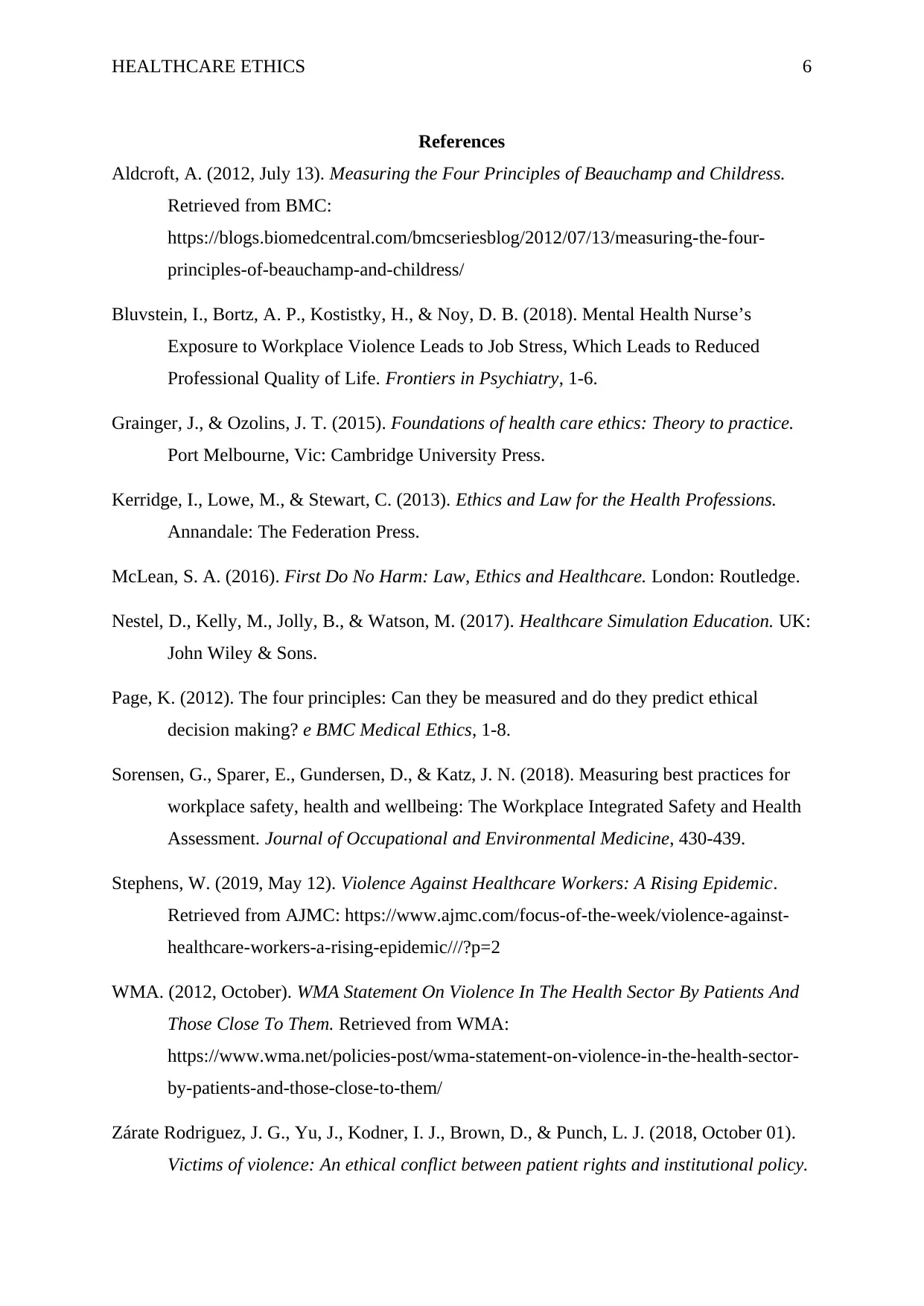
HEALTHCARE ETHICS 6
References
Aldcroft, A. (2012, July 13). Measuring the Four Principles of Beauchamp and Childress.
Retrieved from BMC:
https://blogs.biomedcentral.com/bmcseriesblog/2012/07/13/measuring-the-four-
principles-of-beauchamp-and-childress/
Bluvstein, I., Bortz, A. P., Kostistky, H., & Noy, D. B. (2018). Mental Health Nurse’s
Exposure to Workplace Violence Leads to Job Stress, Which Leads to Reduced
Professional Quality of Life. Frontiers in Psychiatry, 1-6.
Grainger, J., & Ozolins, J. T. (2015). Foundations of health care ethics: Theory to practice.
Port Melbourne, Vic: Cambridge University Press.
Kerridge, I., Lowe, M., & Stewart, C. (2013). Ethics and Law for the Health Professions.
Annandale: The Federation Press.
McLean, S. A. (2016). First Do No Harm: Law, Ethics and Healthcare. London: Routledge.
Nestel, D., Kelly, M., Jolly, B., & Watson, M. (2017). Healthcare Simulation Education. UK:
John Wiley & Sons.
Page, K. (2012). The four principles: Can they be measured and do they predict ethical
decision making? e BMC Medical Ethics, 1-8.
Sorensen, G., Sparer, E., Gundersen, D., & Katz, J. N. (2018). Measuring best practices for
workplace safety, health and wellbeing: The Workplace Integrated Safety and Health
Assessment. Journal of Occupational and Environmental Medicine, 430-439.
Stephens, W. (2019, May 12). Violence Against Healthcare Workers: A Rising Epidemic.
Retrieved from AJMC: https://www.ajmc.com/focus-of-the-week/violence-against-
healthcare-workers-a-rising-epidemic///?p=2
WMA. (2012, October). WMA Statement On Violence In The Health Sector By Patients And
Those Close To Them. Retrieved from WMA:
https://www.wma.net/policies-post/wma-statement-on-violence-in-the-health-sector-
by-patients-and-those-close-to-them/
Zárate Rodriguez, J. G., Yu, J., Kodner, I. J., Brown, D., & Punch, L. J. (2018, October 01).
Victims of violence: An ethical conflict between patient rights and institutional policy.
References
Aldcroft, A. (2012, July 13). Measuring the Four Principles of Beauchamp and Childress.
Retrieved from BMC:
https://blogs.biomedcentral.com/bmcseriesblog/2012/07/13/measuring-the-four-
principles-of-beauchamp-and-childress/
Bluvstein, I., Bortz, A. P., Kostistky, H., & Noy, D. B. (2018). Mental Health Nurse’s
Exposure to Workplace Violence Leads to Job Stress, Which Leads to Reduced
Professional Quality of Life. Frontiers in Psychiatry, 1-6.
Grainger, J., & Ozolins, J. T. (2015). Foundations of health care ethics: Theory to practice.
Port Melbourne, Vic: Cambridge University Press.
Kerridge, I., Lowe, M., & Stewart, C. (2013). Ethics and Law for the Health Professions.
Annandale: The Federation Press.
McLean, S. A. (2016). First Do No Harm: Law, Ethics and Healthcare. London: Routledge.
Nestel, D., Kelly, M., Jolly, B., & Watson, M. (2017). Healthcare Simulation Education. UK:
John Wiley & Sons.
Page, K. (2012). The four principles: Can they be measured and do they predict ethical
decision making? e BMC Medical Ethics, 1-8.
Sorensen, G., Sparer, E., Gundersen, D., & Katz, J. N. (2018). Measuring best practices for
workplace safety, health and wellbeing: The Workplace Integrated Safety and Health
Assessment. Journal of Occupational and Environmental Medicine, 430-439.
Stephens, W. (2019, May 12). Violence Against Healthcare Workers: A Rising Epidemic.
Retrieved from AJMC: https://www.ajmc.com/focus-of-the-week/violence-against-
healthcare-workers-a-rising-epidemic///?p=2
WMA. (2012, October). WMA Statement On Violence In The Health Sector By Patients And
Those Close To Them. Retrieved from WMA:
https://www.wma.net/policies-post/wma-statement-on-violence-in-the-health-sector-
by-patients-and-those-close-to-them/
Zárate Rodriguez, J. G., Yu, J., Kodner, I. J., Brown, D., & Punch, L. J. (2018, October 01).
Victims of violence: An ethical conflict between patient rights and institutional policy.
Paraphrase This Document
Need a fresh take? Get an instant paraphrase of this document with our AI Paraphraser
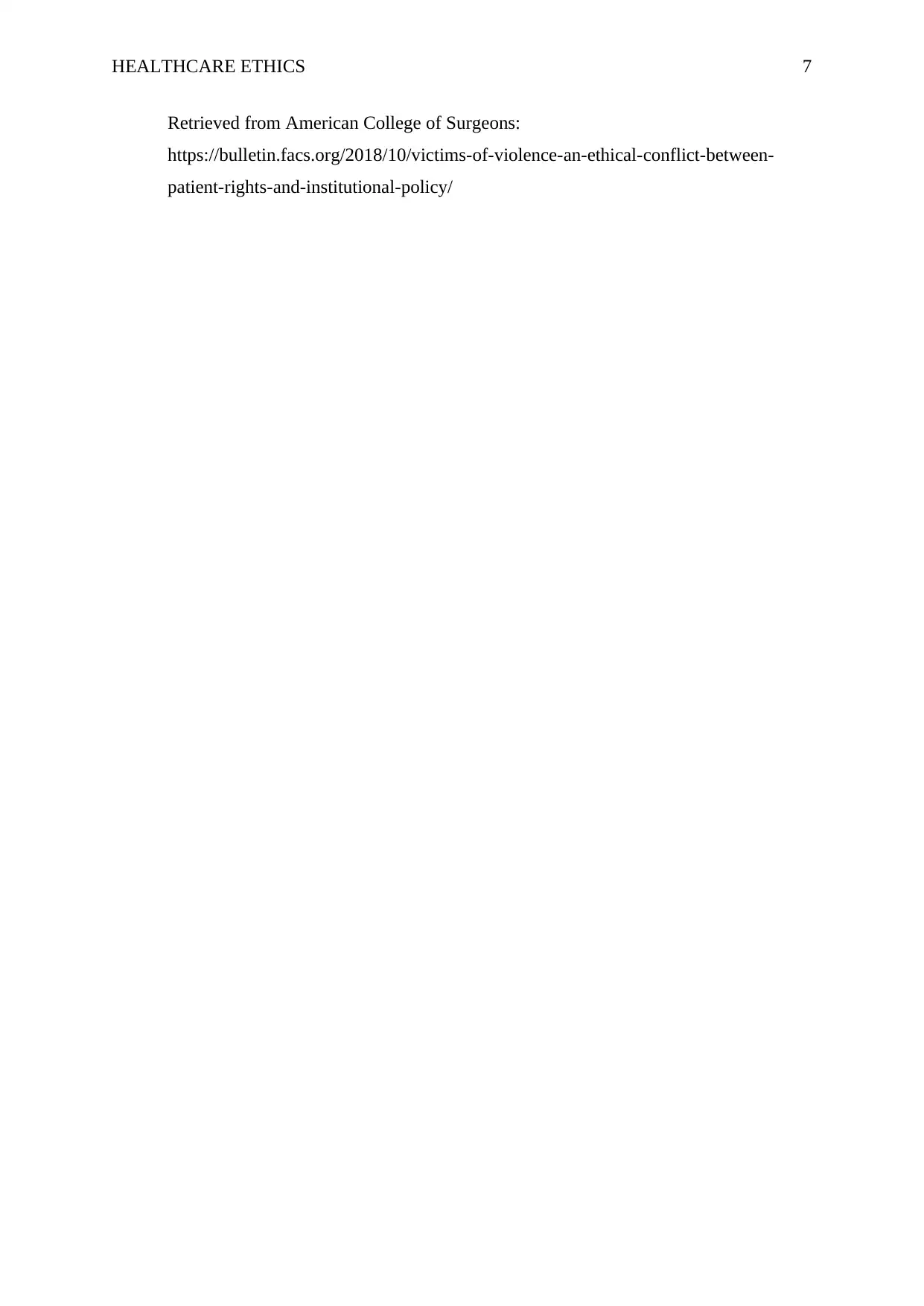
HEALTHCARE ETHICS 7
Retrieved from American College of Surgeons:
https://bulletin.facs.org/2018/10/victims-of-violence-an-ethical-conflict-between-
patient-rights-and-institutional-policy/
Retrieved from American College of Surgeons:
https://bulletin.facs.org/2018/10/victims-of-violence-an-ethical-conflict-between-
patient-rights-and-institutional-policy/
1 out of 8
Related Documents
Your All-in-One AI-Powered Toolkit for Academic Success.
+13062052269
info@desklib.com
Available 24*7 on WhatsApp / Email
![[object Object]](/_next/static/media/star-bottom.7253800d.svg)
Unlock your academic potential
Copyright © 2020–2025 A2Z Services. All Rights Reserved. Developed and managed by ZUCOL.





